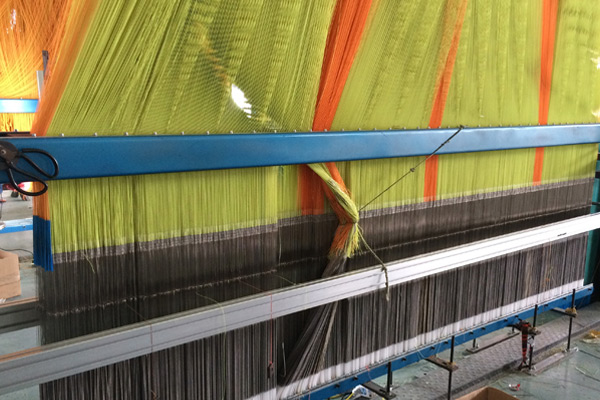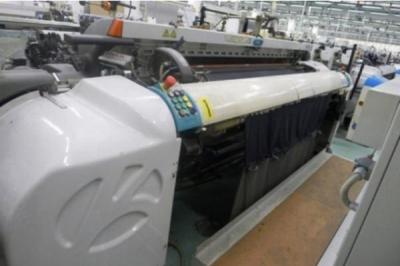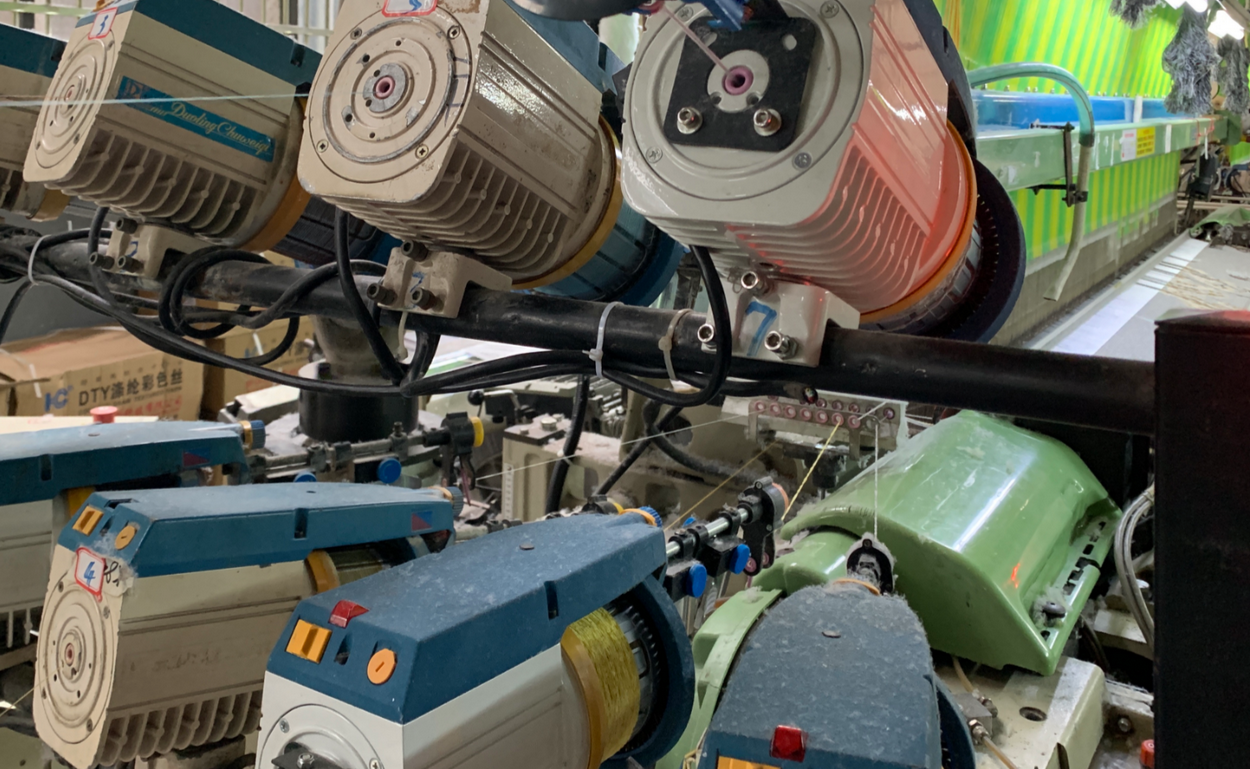The Brief Introduction of Shuttleless Loom
There are many classifications of weaving looms based on several characteristics, including the nature of fabric formation, the method of weft insertion (picking) used, the type of shedding device used, the number of colors of the weft threads that can be used, the type of yarn used, the width of the woven fabric produced, and the number of sheds simultaneously formed along the warp on the weaving machine.
Based on the weft insertion method, weaving looms can be divided into shuttle looms and shuttleless looms. The shuttle loom uses traditional wooden shuttles or plastic shuttles for weft insertion. However, due to the shuttle's large size and weight, and the repeated picking back and forth, shuttle looms have big vibrations, noise, high energy consumption, low running speed, and slow efficiency.
The weft insertion methods of the shuttleless loom are diverse, and shuttleless weaving machines can be classified as follows:
Rapier weaving machines are known for their reliability, performance, and versatility. The weft is withdrawn from the weft package by a rigid or flexible rapier. The rapier loom has the feature of easy color change, suitable for multi-color weft fabrics, and is ideal for producing yarn-dyed fabrics, double-layer velvet, terry fabrics, and decorative fabrics. In the field of rapier weaving, the number of manufacturers is unbelievably high.
Air-jet loom is the most efficient and productive method of inserting weft across the shed. The weft is inserted by means of a fluid known as jet. The air-jet weaving machines are supplied with compressed air from a central compressor in the weave room or area equipped with individual built-in compressors. It is suitable for the production of light to medium-weight fabrics, terry towel fabrics, furnishing fabrics, denim, and so on. With the development of technology, the weaving adaptability of air-jet loom has become broader and broader.
In water jet loom, water is used as the weft insertion medium to generate frictional traction on the weft with the jet of water, so that the weft on the fixed package is introduced into the shed for weaving. Water jet weaving machines are equipped with individual injection pumps to pressurize water supplied from the water main; wastewater is discharged into a drain. The water jet loom has high speed and high output and is mainly suitable for hydrophobic chemical fiber filament fabrics.
In projectile loom weaving, the gripper projectile clamps the weft thread's end and pulls the thread across the shed. The projectile loom has the advantages of stable weft insertion, good fabric quality, and less waste yarn. It is suitable for weaving multi-color weft fabrics, fine and thick fabrics, wide fabrics, and fabrics woven by special yarns. It requires a high precision of the dimensions and performance of the feeding and clamping mechanisms. Only Sulzer projectile weaving machine has achieved significant commercial penetration, although many attempts have been made.
The types of multi-shed or multiphase looms are various, the multi-shed weft insertion by rapier, chain belt, or air-jet, suitable for weaving single-variety but large-volume fabrics. The shuttleless loom's basic feature is to separate the weft package from the shuttle or carry only a small amount of weft and replace the large and heavy shuttle with a small and light weft inserter, providing favorable conditions for high-speed weft insertion. Weft cones or packages are directly used as the weft supply, and the weft insertion mechanism is entered through the weft accumulator so that the loom can get rid of the frequent weft-filling action. Therefore, shuttleless looms are of great significance for increasing fabric varieties, adjusting fabric structure, reducing fabric defects, improving fabric quality, reducing noise, improving working conditions, and reducing energy consumption.
Internationally, the research and development of shuttleless weaving technology started in the 19th century. Since then, many new shuttleless looms have been put on the market, and the technology has developed rapidly. At present, shuttleless looms in developed industrialized countries have replaced shuttle looms.
Based on the weft insertion method, weaving looms can be divided into shuttle looms and shuttleless looms. The shuttle loom uses traditional wooden shuttles or plastic shuttles for weft insertion. However, due to the shuttle's large size and weight, and the repeated picking back and forth, shuttle looms have big vibrations, noise, high energy consumption, low running speed, and slow efficiency.
The weft insertion methods of the shuttleless loom are diverse, and shuttleless weaving machines can be classified as follows:
- Rapier weaving machine
- Pneumatic/air-jet weaving machine
- Water jet weaving machine
- Projectile weaving machine
- Multi-shed/multiphase weaving machine
Rapier weaving machines are known for their reliability, performance, and versatility. The weft is withdrawn from the weft package by a rigid or flexible rapier. The rapier loom has the feature of easy color change, suitable for multi-color weft fabrics, and is ideal for producing yarn-dyed fabrics, double-layer velvet, terry fabrics, and decorative fabrics. In the field of rapier weaving, the number of manufacturers is unbelievably high.
Air-jet loom is the most efficient and productive method of inserting weft across the shed. The weft is inserted by means of a fluid known as jet. The air-jet weaving machines are supplied with compressed air from a central compressor in the weave room or area equipped with individual built-in compressors. It is suitable for the production of light to medium-weight fabrics, terry towel fabrics, furnishing fabrics, denim, and so on. With the development of technology, the weaving adaptability of air-jet loom has become broader and broader.
In water jet loom, water is used as the weft insertion medium to generate frictional traction on the weft with the jet of water, so that the weft on the fixed package is introduced into the shed for weaving. Water jet weaving machines are equipped with individual injection pumps to pressurize water supplied from the water main; wastewater is discharged into a drain. The water jet loom has high speed and high output and is mainly suitable for hydrophobic chemical fiber filament fabrics.
In projectile loom weaving, the gripper projectile clamps the weft thread's end and pulls the thread across the shed. The projectile loom has the advantages of stable weft insertion, good fabric quality, and less waste yarn. It is suitable for weaving multi-color weft fabrics, fine and thick fabrics, wide fabrics, and fabrics woven by special yarns. It requires a high precision of the dimensions and performance of the feeding and clamping mechanisms. Only Sulzer projectile weaving machine has achieved significant commercial penetration, although many attempts have been made.
The types of multi-shed or multiphase looms are various, the multi-shed weft insertion by rapier, chain belt, or air-jet, suitable for weaving single-variety but large-volume fabrics. The shuttleless loom's basic feature is to separate the weft package from the shuttle or carry only a small amount of weft and replace the large and heavy shuttle with a small and light weft inserter, providing favorable conditions for high-speed weft insertion. Weft cones or packages are directly used as the weft supply, and the weft insertion mechanism is entered through the weft accumulator so that the loom can get rid of the frequent weft-filling action. Therefore, shuttleless looms are of great significance for increasing fabric varieties, adjusting fabric structure, reducing fabric defects, improving fabric quality, reducing noise, improving working conditions, and reducing energy consumption.
Internationally, the research and development of shuttleless weaving technology started in the 19th century. Since then, many new shuttleless looms have been put on the market, and the technology has developed rapidly. At present, shuttleless looms in developed industrialized countries have replaced shuttle looms.

 English
English  한국어
한국어  português
português  العربية
العربية  tiếng việt
tiếng việt  ไทย
ไทย  Malay
Malay  हिंदी
हिंदी  Indonesia
Indonesia  বাঙালি
বাঙালি  اردو
اردو 


